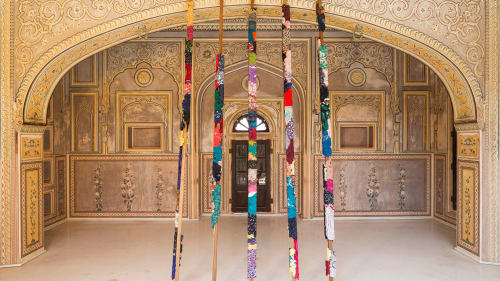Stroll through the extensive grounds of the 18th-century Nahargarh Fort in Jaipur, India, and you may spot objects much more contemporary. At the heart of the fortress is the 1892 Madhavendra Palace, a former seasonal retreat for King Maharaja Sawai Madho Singh and his nine wives, where nearly every structural surface seems to be covered in intricately painted decorative murals. Now, an installation by French artist Arman sits under an expansive interior arch. Another by Indian artist Antia Dube hangs from the ceiling. Throughout the palatial space, 61 contemporary artworks are displayed. Thanks to a collaboration between nonprofit Saat Saath Arts and the government of Rajasthan, the 20,000-square-foot structure is India’s first sculpture park.
“We were genuinely frustrated about how little contemporary public art there was in the country,” explains Saat Saath Arts cofounder Aparajita Jain. “So we went on a scouting mission.” With the blessing of state officials and the help of curator Peter Nagy of Nature Morte, she set her sights on the city of Jaipur (“It’s having a moment, and has a great mix of heritage and new”). Though the chosen palatial site had long been open to the public, Jain wanted art to activate it, without touching its 125-year-old decor. A sculpture park seemed the natural fit. Her nonprofit raised the funding and obtained the artworks on loan. The government of Rajasthan supports the daily upkeep. The first exhibition features works ranging in date from 1984 to 2017. A second show, with a nearly new roster of artists, will open in December.
“I think the contemporary artworks and the historic space work together like magic,” she says. “One of the thoughts that a lot of Indians specifically have is that we are a country with deep heritage, yet the younger generation keeps pretty global. We don’t wish away our past. At the same time, we don’t want to write off our present. I think we are living examples of what was and what is, today; we are this new amalgamation.”
